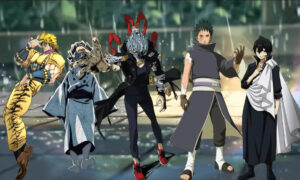The Main Character is the Villain 23
In literature and storytelling, protagonists have traditionally been portrayed as virtuous heroes striving to overcome obstacles and triumph over evil. However, there has been a growing trend in recent years where authors challenge this norm and present a unique perspective by making the main character the villain. One example is the story “The Main Character is the Villain 23,” where the protagonist plays the antagonist role, defying conventional storytelling conventions and leaving readers questioning their moral compass.
He is a Selfish Person in The Main Character is the Villain Chapter 23
In Chapter 23 of “The Main Character is the Villain,” the central character is depicted as a selfish individual driven by their desires and interests. This deviation from the traditional hero archetype allows readers to explore human nature’s complexities and humanity’s darker aspects. The main character’s selfishness drives the plot, creating a morally ambiguous narrative that intrigues readers.
He is a Manipulative person in The Main Character is the Villain Chapter 23
Chapter 23 delves into the manipulative nature of the main character in “The Main Character is the Villain.” The protagonist uses cunning tactics and deceit to achieve their goals, adding depth to the story’s conflict and raising questions about the true nature of manipulation. This portrayal of the main character as a manipulative force challenges readers to question their perceptions of right and wrong. It provides a fresh perspective on the traditional hero-villain dynamic.
He is a Smart Person in The Main Character is the Villain Chapter 23
Intelligence and cunning are essential traits of any compelling villain, and Chapter 23 of “The Main Character is the Villain” highlights just how smart the main character can be. Their ability to devise intricate plans and outwit their adversaries adds complexity to the narrative and keeps readers guessing about the character’s next move. This portrayal of a highly intelligent villain allows for a riveting reading experience and keeps the audience engaged throughout the story.
The Main Character is the Villain 23: A Critical Analysis
The twenty-third chapter of “The Main Character is the Villain” presents an excellent opportunity for critical analysis of the narrative’s structure and thematic elements. By flipping the conventional hero-villain relationship, the author challenges societal norms and provokes thought on the nature of morality. This chapter serves as a turning point in the story, forcing readers to confront the main character’s villainous traits and ponder the implications of their actions.
One intriguing aspect of this chapter is the moral ambiguity of the main character. By portraying the protagonist as a villain, the author blurs the lines between good and evil, prompting readers to question whether the ends justify the means. This exploration of moral relativism opens up fascinating discussions about the complexities of human behaviour and the shades of grey that exist in our decisions.
Moreover, “The Main Character is the Villain Chapter 23” offers insight into the psychology of a criminal protagonist. By delving into the character’s motivations, fears, and desires, readers gain a deeper understanding of the intricate web of emotions that drive the main character’s actions. This level of character development adds depth to the narrative and contributes to the story’s overall richness.
Additionally, the chapter’s plot twists and unforeseen developments captivate readers, reinforcing that the main character is not one-dimensional but a multi-faceted individual with a complex and compelling personality. This depth in character portrayal challenges readers to empathize with a character they might typically despise, blurring the lines between hero and villain.
Impact of the Main Character as a Villain 23 on the Narrative
The decision to make the main character the villain in Chapter 23 of the story profoundly impacts the narrative. It creates a compelling contrast with traditional storytelling and adds an element of unpredictability that keeps readers invested in the plot’s twists and turns. Challenging the conventional hero’s journey makes the narrative more thought-provoking and emotionally charged, leaving a lasting impression on readers’ minds.
The portrayal of the main character as a villain also allows for exploring complex themes and ideas. Issues such as morality, the nature of power, and the consequences of selfish actions are brought to the forefront, prompting readers to ponder the story’s deeper implications. This depth in thematic exploration elevates the narrative and sets it apart from more conventional tales.
Advantages and Challenges of Writing a Villainous Main Character
Creating a villainous main character presents both advantages and challenges for authors. One of the primary advantages is the opportunity for unique storytelling. By deviating from the traditional hero’s journey, authors can offer readers fresh perspectives and explore themes that might otherwise remain unexamined. This approach can lead to a more memorable and impactful reading experience.
Additionally, a villainous main character can be more relatable and human in their flaws and struggles. Readers may connect with the character’s vulnerabilities and insecurities, making them more three-dimensional and realistic. This connection can foster empathy and introspection, prompting readers to question their motives and actions.
However, writing a villainous main character also comes with challenges. One of the most significant hurdles is ensuring the character remains compelling despite its negative traits. Striking the right balance between the character’s villainous actions and their redeeming qualities is crucial to maintaining reader interest and engagement.
Another challenge is navigating the fine line between making the character morally ambiguous and crossing into the realm of unsympathetic or unlikeable. While a flawed protagonist can be intriguing, if the character becomes too despicable, it may alienate readers and lead to a disengaged audience.
Examples of Stories with Villainous Main Characters
Several notable works of literature and media have successfully featured villainous main characters, challenging traditional storytelling conventions and captivating audiences. Some examples include:
1. “Breaking Bad” (TV Series): This critically acclaimed television series follows Walter White, a high school chemistry teacher turned methamphetamine manufacturer. As the series progresses, Walter’s transformation into a ruthless drug lord challenges viewers’ perceptions of morality and the consequences of his actions.
2. “American Psycho” (Novel): Bret Easton Ellis’s novel introduces readers to Patrick Bateman, a wealthy investment banker who leads a double life as a sadistic serial killer. The novel’s exploration of Bateman’s psychopathic tendencies offers a disturbing and thought-provoking examination of human nature.
3. “Gone Girl” (Novel and Film): Gillian Flynn’s best-selling novel, adapted into a film, features Amy Dunne, a cunning and manipulative character who masterminds an elaborate plan to frame her husband for her murder. The story’s exploration of deception and psychological manipulation is thrilling and unsettling.
FAQs
1. Why do authors make the main character the villain?
Authors may make the main character the villain to subvert traditional storytelling norms, offer fresh perspectives and delve into complex themes of morality and human nature. This approach can lead to more thought-provoking and emotionally charged narratives.
2. Do readers prefer stories with villainous main characters?
Reader preferences vary widely, and while some may enjoy the depth and complexity that villainous main characters bring to a story, others may prefer more traditional hero-driven narratives. Ultimately, the success of such stories depends on their execution and the author’s ability to create compelling and relatable characters.
3. What are the potential risks of Writing a villainous main character?
One of the risks of writing a villainous main character is maintaining reader engagement and sympathy for the character. Striking the right balance between the character’s negative traits and their redeeming qualities is essential to avoid alienating the audience.
4. Can a villainous main character be redeemed by the end of the story?
Redeeming a villainous main character is possible but requires careful and convincing character development. The character must undergo a transformation that feels authentic and believable to readers, leading to their growth and potential for redemption.
5. What can readers learn from stories with villainous main characters?
Stories with villainous main characters provide opportunities for introspection and exploration of complex themes such as morality, power, and human nature. Readers may gain insights into the shades of grey in decision-making and empathy for characters with flawed personalities.










